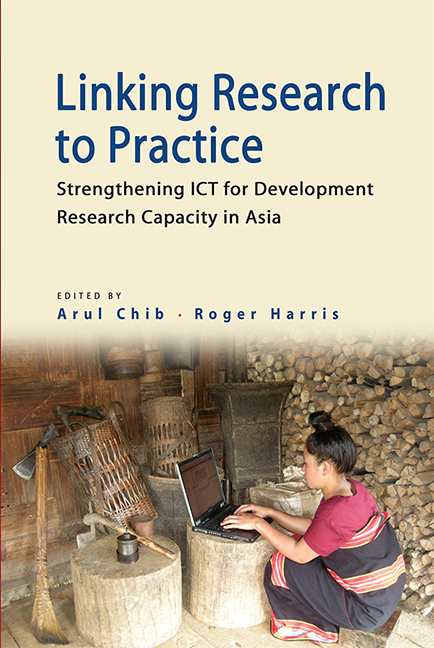Book contents
- Frontmatter
- Contents
- List of Tables
- List of Figures
- Foreword
- Preface
- Acknowledgement
- SECTION I MANAGEMENT PERSPECTIVES: INSIDERS' THOUGHTS ON THE PROGRAMME
- SECTION II RESEARCH PERSPECTIVES: THEORETICAL REFLECTIONS BY EXPERTS
- 5 ICTD Praxis: Bridging Theory and Practice
- 6 Messy Methods for ICT4D Research
- 7 Ethics and ICTD Research
- 8 ICTD Curriculum Development and Professional Training: Mainstreaming SIRCA Research Models
- 9 Multi-stakeholder Perspectives Influencing Policy-Research-Practice
- 10 From Production… To Dissemination… To Adoption
- SECTION III RESEARCH OUTPUTS
- SECTION IV SYNTHESIS AND CONCLUSION
- About the Contributors0
- Index
6 - Messy Methods for ICT4D Research
from SECTION II - RESEARCH PERSPECTIVES: THEORETICAL REFLECTIONS BY EXPERTS
Published online by Cambridge University Press: 21 October 2015
- Frontmatter
- Contents
- List of Tables
- List of Figures
- Foreword
- Preface
- Acknowledgement
- SECTION I MANAGEMENT PERSPECTIVES: INSIDERS' THOUGHTS ON THE PROGRAMME
- SECTION II RESEARCH PERSPECTIVES: THEORETICAL REFLECTIONS BY EXPERTS
- 5 ICTD Praxis: Bridging Theory and Practice
- 6 Messy Methods for ICT4D Research
- 7 Ethics and ICTD Research
- 8 ICTD Curriculum Development and Professional Training: Mainstreaming SIRCA Research Models
- 9 Multi-stakeholder Perspectives Influencing Policy-Research-Practice
- 10 From Production… To Dissemination… To Adoption
- SECTION III RESEARCH OUTPUTS
- SECTION IV SYNTHESIS AND CONCLUSION
- About the Contributors0
- Index
Summary
INTRODUCTION: INSIDE THE CLEAN ROOM OF RESEARCH METHODS
The semiconductor industry uses a clean room in which to manufacture silicon chips used in computers. A clean room is purged of dust particles as even a tiny mote can destroy an entire production run. A typical clean room has twelve or less particles per cubic metre, as compared to normal air that has millions of particles in the same amount of space. Those working in clean rooms have to enter through air locks that purge their clothes of particles, and also have to wear space-suit like coveralls to maintain the cleanliness.
Much of ICT4D research is criticised for not having rigorous methods — papers generalise from scanty data, case studies do not have adequate depth, statistical analysis is loose, and analytical generalisations are not convincing. The international community of ICT4D research demands rigour, in the form of tighter controls over data collection, larger and more in-depth data for analysis and the use of well-established methods, in the broad domains of qualitative or of quantitative analysis. Researchers are urged to have clear and precise plans for research, which will include setting up research questions or hypothesis based on an in-depth literature survey of the extant literature, a clearly specified plan for the kind and quantity of data that will be collected, the manner in which the data collection will proceed, and a very precise outline of the analysis method.
Call-for-proposals from granting agencies, proposal writing guidelines from research departments, and how-to books on researchch; all emphasise the above steps for conducting research. Everything has to be spelled out in as much detail as possible, so that reviewers, department committees, international funding agencies, and others can judge the rigour, relevance, and potential value of the proposed research. Even when the research is completed and submitted for publication in peer-reviewed journals, the reviewers want a detailed and clear exposition of the method planned and followed for the research and data collection.
- Type
- Chapter
- Information
- Linking Research to PracticeStrengthening ICT for Development Research Capacity in Asia, pp. 58 - 67Publisher: ISEAS–Yusof Ishak InstitutePrint publication year: 2012



